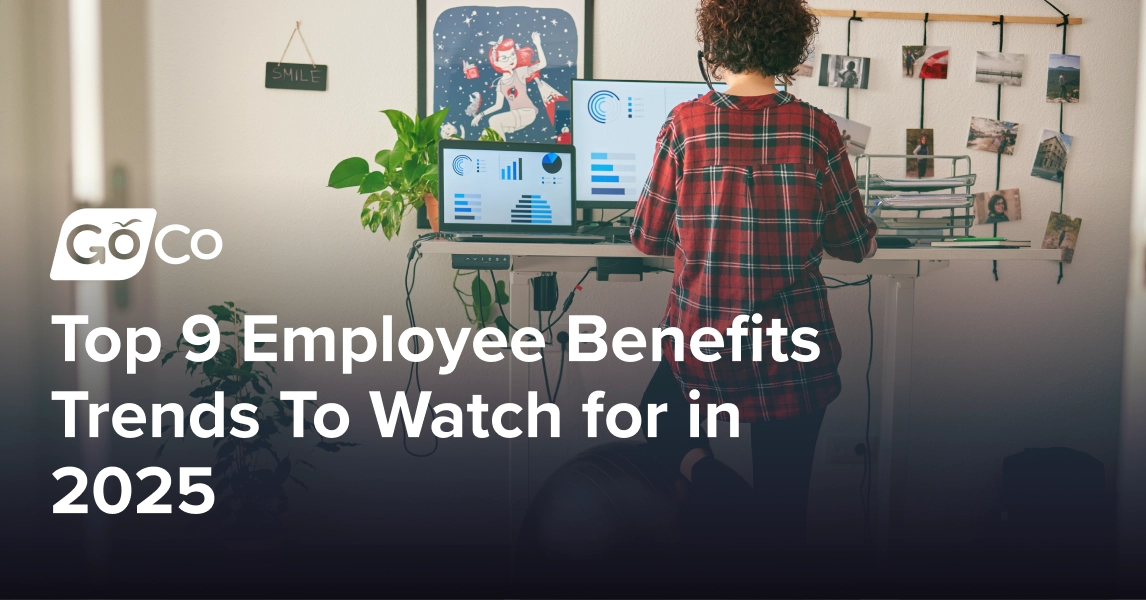Top 9 Employee Benefits Trends To Watch for in 2025
An overview of the trending employee benefits for 2025 and why your organization should consider offering them.
by Anna Coucke - July 30th, 2024
Table of Contents
- Fair Compensation and Pay Transparency
- Retirement Savings
- Debt Management and Financial Education
- Mental Health Support
- Flexible and Inclusive Work Arrangements
- Personalized, Flexible Healthcare
- Childcare and Fertility Benefits
- Professional Development
- Benefits for Part-Time Employees
- Final Thoughts
Today’s workforce is continuing to undergo a profound transformation, characterized by evolving employee expectations and economic shifts — and your benefits package must keep up.
To attract, retain, and engage top talent into 2025, businesses must continuously reevaluate their benefits offerings to ensure they have competitive packages that current and potential employees will value.
In this article, we will explore some of the employee benefits offerings that are quickly gaining traction among employees, and why it is important to consider adding them to your benefits offerings.
1. Fair Compensation and Pay Transparency
With inflation and its impact on purchasing power continuing to be a top concern among employees this year, regular compensation assessments and competitive pay increases have become essential to retain employees. 82% of surveyed workers said that they are more productive and fulfilled by their work when they perceive their pay to be fair, and were also found to be more innovative and loyal to employers who compensated them well.
Additionally, pay transparency initiatives are gaining momentum, with Massachusetts becoming the latest state to pass legislation around pay transparency. Pay transparency shouldn’t be considered just for legal reasons, though; it is proven to be a powerful tool in recruitment and fosters fairness, trust, and equity within organizations.
82% of surveyed workers said that they are more productive and fulfilled by their work when they perceive their pay to be fair.
2. Retirement Savings
While traditional pensions have declined, retirement savings plans like 401(k)s continue to be a popular choice for both employees and employers for several reasons. From an employee perspective, 401(k) plans offer significant tax advantages by allowing individuals to contribute pre-tax dollars to their retirement accounts, reducing their taxable income.
Additionally, many employers offer matching contributions, essentially providing free money to employees who participate, and educating employees on how the power of compound interest over time can turn relatively small contributions into substantial retirement savings.
3. Debt Management and Financial Education
It’s no secret that financial stress can significantly impact employee morale, productivity, and overall well-being. To mitigate these challenges, employers are increasingly focusing on financial wellness benefits for 2025.
Providing employees with resources to manage debt and make informed financial decisions can significantly improve their overall well-being and shows a genuine interest in their financial health and knowledge. Financial wellness programs can include budgeting tools, debt counseling, and education on popular personal finance topics such as homeownership and investing.
4. Mental Health Support
With nearly 50 million Americans currently experiencing some type of mental illness, prioritizing mental health is no longer a perk but a necessity for creating a high-performing and supportive work environment. Mental health services and mental health day policies have become increasingly popular benefits due to the growing recognition of the significant impact mental health has on overall well-being and productivity.
Employees increasingly value employers who prioritize their mental health, as it demonstrates a commitment to their overall well-being, reduces stigma, and improves employees' abilities to cope with stress and combat workplace burnout.
5. Flexible and Inclusive Work Arrangements
Flexible remote and hybrid work arrangements are continuing to gain popularity, with around 23% of U.S. workers currently working hybrid or remote roles. Employees in flexible work arrangements value the ability to balance work and personal life, leading to increased job satisfaction, reduced stress, and improved overall well-being. Additionally, flexible arrangements accommodate diverse needs, such as caregiving responsibilities or disabilities, fostering a more inclusive and equitable workplace.
For employers, offering flexible work options can enhance recruitment and retention by attracting top talent seeking work-life balance. It is also found to increase employee satisfaction, which often translates to higher productivity, lower turnover rates, and reduced absenteeism. Moreover, flexible arrangements can expand the talent pool to include individuals who might otherwise be excluded due to geographic location or personal circumstances.
6. Personalized, Flexible Healthcare
Rising healthcare costs continue to challenge employers and employees. According to USA TODAY, The average annual premium for employer-sponsored insurance has risen to $8,435 for an individual and $23,968 for a family plan. Simultaneously, employees are looking for more choice and customization in their benefits packages.
To address this issue, companies are exploring various strategies, such as budget-friendly options like health savings accounts (HSAs), tiered plans, telehealth, high-deductible healthcare plans, and wellness programs that incentivize healthy behaviors while also reflecting the diverse needs of their workforce.
The average annual premiums for employer-sponsored insurance have risen to $8,435 for an individual and $23,968 for a family plan.
7. Childcare and Fertility Benefits
For employees who have started or are looking to start a family, the rising costs of family services such as childcare, adoption, or fertility treatments can quickly become a large financial burden, with childcare alone consuming up to 10% of a working couples’ income.
In addition to offering maternal and paternal leave to new parents, businesses should also consider how they can be more inclusive and supportive of a wider range of employee needs around family planning.
8. Professional Development
In recruitment and retention, continuous learning and professional development have emerged as increasingly important benefits, particularly among younger generations who want to build a lucrative career. This benefit doesn’t just help employees, though; it also helps their companies get ahead. Predictably, employees who are given the opportunity to learn new skills and tools are shown to be more engaged, innovative, and productive in their roles.
With technology evolving at such a rapid rate, it is more important now than ever that employees stay ahead of the curve by learning about the latest trends and technologies. Offering benefits such as education stipends is an effective (and relatively low-cost) way to keep your employees engaged and growing.
9. Benefits for Part-Time Employees
The rise of the gig economy and flexible work arrangements have led to a significant increase in the number of part-time workers in recent years. However, these workers have typically not been offered the same benefits as their full-time counterparts, such as healthcare, paid time off, and retirement accounts.
Faced with an increasingly competitive talent landscape coupled with higher turnover rates, more companies are beginning to offer more benefits to part-time employees. However, this isn’t just about attracting and retaining talent; offering comprehensive benefits to part-time employees demonstrates a commitment to inclusivity and work-life balance.
Final Thoughts
As we navigate an era defined by rapid change and evolving employee expectations, businesses must prioritize employee well-being and satisfaction with comprehensive benefits offerings in order to continue attracting and retaining employees. By investing in benefits that are flexible, customizable, and employee-centric, organizations can create a thriving work environment that attracts, retains, and engages top talent for years to come.
If you are an employer looking for a modern benefits and HR solution, GoCo allows you to easily manage all of your benefits in one place, including health, dental, vision, life, accident and disability, HSA, FSA, HRA, commuter benefits, and more.
GoCo equips employees with convenient and comprehensive self-service enrollment, which allows them to view plans at a glance, easily understand coverage, and enroll in minutes. Benefits are also kept in sync with your payroll and insurance carriers within GoCo, which makes the management process easier.
Want to see for yourself how simple benefit administration (and much more) can be with GoCo? Learn more about our automated benefits administration software and take a free tour of our platform today!
Ready to explore GoCo?
Check out our interactive Product Tour.
Take a Tour →Please fill your info to start experiencing GoCo
Recommended Posts
Leveraging the Power of HR Automation
Blog Articles
Search...
Product
GoCo
Resources
Articles
eBooks
Webinars
Customer Stories





